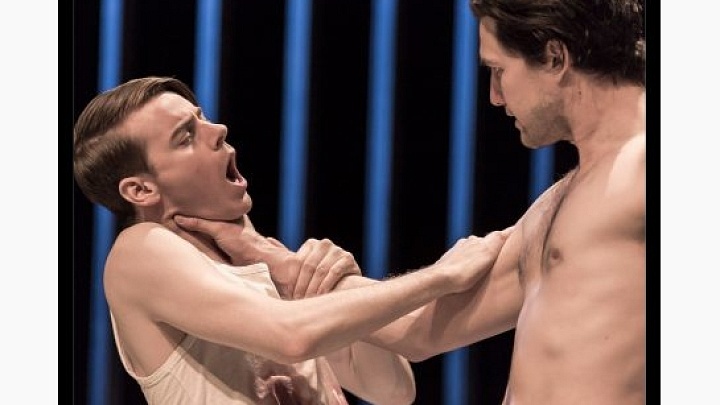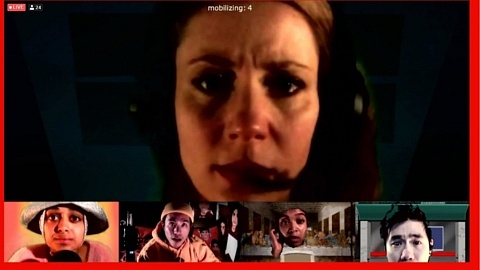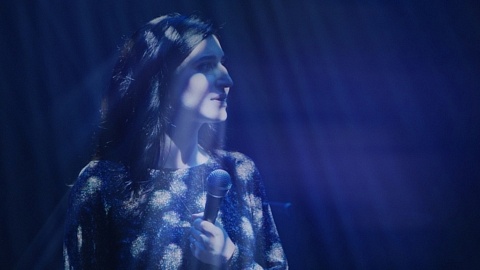Rick Roberts’ Orestes, directed by Richard Rose, confronts the progressively blurring lines between real life and virtual life in a heightened version of the...
Country Night at Buddies in Bad Times: Tom at the Farm
By Alex Jackson
Buddies in Bad Times conjures up a gripping depiction of rural Canada, enthralling audiences in its production of Tom at The Farm by critically acclaimed Québécois playwright Michel Marc Bouchard. In this first English translation by Linda Gaboriau, Tom (Jeff Lillico) visits his late lover’s rural family, introducing himself simply as the “co-worker” of his deceased boyfriend in order to side-step a post-mortem outing of his lover. Tom faces the brutal violence of Francis – his lover’s older brother – who demands that Tom keep his true relationship with his lover a secret from mourning mother Agathe (Rosemary Dunsmore). Tom and Francis embark on a disturbing, abusive, and – fascinatingly – erotic relationship, exploring the depths of grief and its impact on those who remain behind after death.
John Gzowski’s sound design paints the farmland with an eerie brush, accentuating Tom’s apparent descent into madness. Set design by Camellia Koo draws the audience into the world of the family’s secrets by removing the walls of the farmyard house and cattle barn, leaving only the framework. The removal of the walls allows the audience to peer into the secluded lives of Francis and Agathe and provides insight into how isolation has warped their minds – especially Francis’. The single point perspective orientation of the stage – narrowing menacingly into the back wall – enhances the nightmarish quality of both Tom’s grief and the abuse he faces at the hands of Francis.
Eda Homes’ direction showcases the clash of the classes; the sophisticated queer city boy versus the the heteronormative-oriented countryside. Truly exceptional performances by the entire ensemble leave the audience laughing morosely during Dunsmore’s existential struggle over a bowl of leftover pasta salad and disturbed by Irving’s sensual physicality and recounting of a traumatic adolescence. Tom’s direct address to the audience flows seamlessly into stunted and anxious dialogue, and the use of textual repetition effectively highlights the sexual and sensual intimacy between Francis and Tom, whose relationship enthrals the audience as both men become entrenched in their psychologically and physically abusive relationship.
The ambiguous location of the farm is a tricky situation. If we agree that the rural setting is Ontario – and not Quebec, as in the original text – then Tom’s urban centre is most likely Toronto. This is never established, even when Francis tells Tom “We don’t speak French”. I can’t help but wonder about the potential for racial diversity in this newly translated piece. While the production deals with so many (unfortunately still) controversial issues surrounding queer identities and the socio-economic separation of classes, the production overlooks the representation of race. Holmes could embrace the ethnic diversity that Toronto has to offer with the inclusion of non-white performers, possibly in the realm of the fake girlfriend Natalie (yes, it is mentioned she has blonde hair, but seeing as we’re into the world of translation anyway a simple line change doesn’t seem like much). It is understandable that this show chooses to focus on the white rural class, but I see more room for breaking down the assumption of “whiteness” by engaging more readily with the work of non-white actors.
Related Posts
Every year the University of Windsor School of Dramatic Art produces multiple plays featuring its fourth-year students. This year, under the circumstances of...
Pre-recorded digital theatre can reduce performers to ghosts. The moment of ephemerality has passed; a recording hopes to capture its spirit for the viewer. I...
Every year the University of Windsor School of Dramatic Art produces multiple plays featuring its fourth-year students. This year, under the circumstances of...
Pre-recorded digital theatre can reduce performers to ghosts. The moment of ephemerality has passed; a recording hopes to capture its spirit for the viewer. I...
Leave a Reply (Cancel Reply)
Twitter Feed
Blogroll
DARTcritics.com is partially funded by the Marilyn I. Walker School of Fine and Performing Arts, in support of student learning; experiential education; student professionalization; public engagement with the teaching, learning and production activities of the Department of Dramatic Arts; new ways of thinking; and the nurturing of links with our communities.





